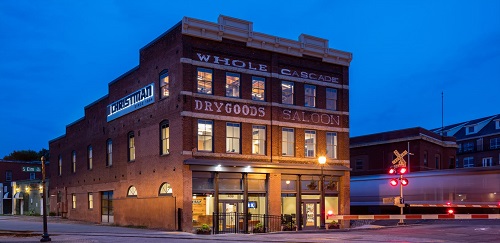
Best Building Project Under $5 Million
The historic Cascade Saloon in downtown Greensboro, located in the city’s South Elm Street Historic District, is a cherished but long neglected facility that had little hope for future use until this project gave it a new life. The Christman Company formed a public/private partnership with Preservation Greensboro and its development fund together with the City of Greensboro to save the structure, which is listed on the National Register of Historic Places, and transform it into Christman’s new regional offices.
Constructed in 1895 as a saloon and general store, the brick masonry building had served the community in many capacities over the years. But by the 1980s, the building had been all but abandoned; over the next three decades, the Saloon fell into a state of dangerous disrepair.
The saloon’s challenging downtown site, nestled between four major rail lines, made it easy to see how previous attempts to save the saloon seemed too difficult to achieve. Demolition of the building would surely result in a huge gap in the downtown landscape, as further development would be logistically impossible.
In addition to the difficult logistics, the condition of the building itself (near collapse, with some citizens and groups stating the building should be razed) made it seem that the building was destined for demolition. Thanks largely to the efforts and passion of Preservation Greensboro, the community ultimately recognized the importance of and significance in saving the building, and its unique heritage.
Renovations to the three-story building presented significant technical challenges to the construction team. Operating between two functioning railroad tracks adjacent to the site, stabilization of the historic masonry structure, working with extremely limited space for construction materials and deliveries, and replication of the historic exterior cornice were just some of the key project challenges that the team overcame. A construction approach of “building a ship in a bottle” was used to erect a new support structure inside the historic brick walls.
And speaking of brick, new bricks would not have matched the patina and look of the original brick. Thankfully, the demolition of an interior brick wall provided the team with a plentiful supply of the Cascade’s original brick. The masonry team used over 1,000 reclaimed bricks, all from this interior wall, to repair the building. The use of original brick and carefully matched mortar have restored the Cascade’s exterior brick to its original glory, without compromising its historic beauty.
The redevelopment and rehabilitation of the obsolete building, once labeled “unsalvageable,” now is a modern, functional office space which respects and retains its historic fabric and character. The three-story, 9,245-square foot building now serves as home to 70+ full-time employees.
It is hoped the vibrancy of the renewed building will help it reclaim its position among Greensboro’s most memorable and distinctive landmark buildings while serving as a catalyst to further engage the south end of downtown.
The Christman Company would like to honor their Pinnacle Partners who went above and beyond on this project:
- Tise-Kiester Architects
- Bennett Preservation Engineering